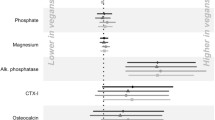Abstract
Although about 25% of all hip fractures occur in men, little is known about the pattern of their age-related bone loss and its main determinants. The aim of this cross-sectional study was to evaluate the age-related changes of intestinal calcium absorption, bone mass, and bone turnover in normal men. In 70 normal males (age 17–91 years), we measured spinal and forearm bone density (FBD) (by DXA), fractional intestinal calcium absorption (by oral test), serum immunoreactive parathyroid hormone (PTH), dietary calcium intake (diet records), biochemical markers of bone turnover (serum alkaline phosphatase (ALP), osteocalcin, urine calcium, creatinine, and hydroxyproline), and 1,25(OH)2D3 serum levels. Vertebral bone density (VBD) showed a modest decline before age 50 and a greater decline after age 50, whereas FBD presented a significant decrease with advancing age starting at age 40, suggesting a predominant age-related cortical bone loss. Intestinal calcium absorption (47CaFA) and serum 1,25(OH)2D3 also presented an age-related decline similar to FBD. Simple correlation analysis revealed that age was significantly related to 47CaFA (r = 0.60), calcium intake (r = 0.32), VBD and FBD (r = 0.79 and 0.63, respectively), serum 1,25(OH)2D3 (r = 0.69), and serum iPTH (r = 0.72). No significant correlation was found between age and biochemical markers of bone remodeling. Partial correlation and stepwise variable selection analyses, using 47CaFA and bone mass as dependent variables, showed that in normal males, serum 1,25(OH)2D3 and dietary calcium intake were the main contributors (64%) to 47CaFA variability, whereas only age accounted for 63% of VBD and age and dietary calcium accounted for 45% of FBD variability. These results indicate that bone loss in men accelerates after age 50 years and that among other factors, intestinal calcium malabsorption and 1,25(OH)2D3 serum levels play a role.
Similar content being viewed by others
Author information
Authors and Affiliations
Additional information
Received: 19 November 1996 / Accepted: 26 January 1998
Rights and permissions
About this article
Cite this article
Agnusdei, D., Civitelli, R., Camporeale, A. et al. Age-Related Decline of Bone Mass and Intestinal Calcium Absorption in Normal Males. Calcif Tissue Int 63, 197–201 (1998). https://doi.org/10.1007/s002239900514
Published:
Issue Date:
DOI: https://doi.org/10.1007/s002239900514




